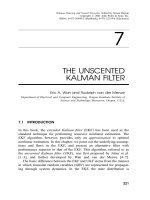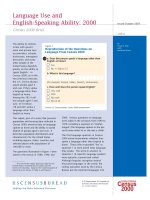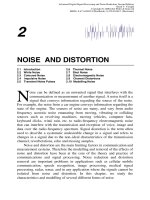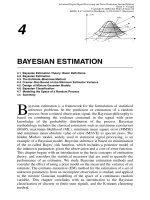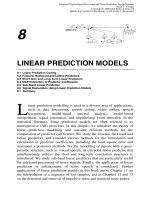Tài liệu Physical Activity and Women’s Health pptx
Bạn đang xem bản rút gọn của tài liệu. Xem và tải ngay bản đầy đủ của tài liệu tại đây (52.95 KB, 12 trang )
Ph ysic al A ctiv ity and Wome n’s
He alth
Ch rist ine L. W ells
ARI ZONA STA TE UNI VERS ITY
A NOTE FRO M TH E ED ITOR S
ORIGINALLY PUBLISHED AS SERIES 2, NUMBER 5, OF THE PCPFS RESEARCH DIGEST.
HI GHLI GHT
“W e ha ve fa iled —in ph ysic al ed ucat ion an d me dici ne—t o cl arif y
fo r wom en th e im port ance of ha bitu al ph ysic al ac tivi ty,
ph ysic al fi tnes s, an d ma inte nanc e of ‘n orma l’ bo dy we ight . We
mu st mo unt ne w ed ucat iona l ef fort s to de velo p cu ltur ally
se nsit ive an d et hnic -spe cifi c he alth me ssag es an d pr ogra ms.”
Many more women are active today compared to when the first studies of activity in America
were conducted. However, as a group, girls and women are still less active than boys and men.
Some of this difference in activity between males and females can be explained by the
historical disparity in opportunities for females. Since 1972, when Title IX was implemented,
more females have become involved in organized sport. We have yet to discover the effects of
this increased participation on lifetime activity among females.
Much of the literature concerning health benefits of physical activity is based on studies
done primarily with men. Only recently have large-scale studies been initiated to investigate
the effects of physical activity on women’s health and wellness. Chris Wells, the author of this
paper, has been a pioneer in the study of physical activity for women. As you will see, much
more research studying girls and women is necessary, but much has been accomplished in
recent years. Diseases often thought to be “diseases of men” affect women as well as men.
The evidence now suggests there are many health benefits for females who become regularly
involved in physical activity.
This article clearly shows that women, especially women of color, are more likely to be
sedentary. Sedentary living increases risk of heart disease, various cancers, hypertension,
stroke, and non-insulin diabetes. Controlling body fatness, another factor that is related to
increased risk of chronic diseases, is also associated with inactivity. Continued efforts that
focus on increasing physical activity among girls and women will reduce the risk of chronic
diseases and death.
IN TROD UCTI ON
Healthy People 2000 sets forth the nation’s health goals for the next decade (Public Health
Service, 1990). One of three primary goals is to reduce health disparities among Americans.
This goal addresses reducing preventable disease and death from chronic diseases among
racial and ethnic minorities in the United States. Also of importance is the disparity that exists
among women as compared to men and among women of different racial and ethnic groups.
It is significant that of eight priorities for health promotion and disease prevention, increased
physical activity and fitness leads the list. If we could increase physical activity and decrease
obesity, the reasoning goes, much of the premature death, disease, and disability of high-risk
populations could be virtually eliminated. But, what is the relationship between physical
activity and health in women? Can a strong case be made for increasing physical activity in
women as a primary preventive measure for major chronic disease? Will increasing physical
activity reduce risk of disease and improve the health and wellness of women? Is physical
activity as beneficial for women as research has shown it to be for men?
This paper will address this issue by presenting the growing body of evidence for the
beneficial relationships between physical activity (including exercise and physical fitness) and
the major chronic diseases in women, with special reference to race and ethnicity. It will be
evident that American women need to make significant lifestyle modifications to alter their
health risks, and that health and educational professionals must mount new efforts to develop
culturally appropriate and sensitive health programs and educational materials.
But, first, how physically active are American women?
HO W PH YSIC ALLY ACT IVE ARE AMER ICAN WOM EN?
The most current data on habitual physical activity are from the Behavioral Risk Factor
Surveillance System (BRFSS), a state-based, random-digit-dialed telephone survey that
collects self-reported information from a representative sample of people 18 years of age and
older. In 1992, BRFSS data were available from 55,506 women from 48 states and the District
of Columbia (Prevalence of recommended levels . . . , 1995). These women were asked about
the frequency, duration, and intensity of their leisuretime physical activity (LTPA) during the
preceding month. Respondents were categorized as having (1) no LTPA, (2) irregular activity
that did not meet the recommended criteria for either vigorous physical activity (≥20 minutes
per day of vigorous physical activity on ≥3 days per week) or the newer moderate activity
recommendation (accumulation of >30 minutes per day of moderate activity on ≥5 days per
week) (Summary Statement, CDC and ACSM, 1993). Only 27.1 % of these women reported
participation in recommended activity levels, and 30.2% reported no leisuretime physical
activity whatsoever. The prevalence of no LTPA increased with age from 25.6% among
women 18 to 34 years to 42.1 % among women over age 65. Racial/ethnic disparity was
clearly evident. Black non-Hispanic women were less likely to be active (43.6%) than
Hispanic women (40.2%) or white non-Hispanic women (27.6%). Physical inactivity was
inversely related to income. Women with ≤$14,999 annual household income were most
likely to have no LTPA (40.2%), and women with ≥$50,000 annual income were least likely
to have no LTPA (21.2%).
BRFSS data from 1991 and 1992 were combined to increase precision of prevalence
estimates for minority populations (Prevalence of selected . . . , 1994). Sedentary lifestyle was
defined as reported participation in fewer than three 20-minute sessions of LTPA per week
excluding usual job-related physical activity. A sedentary lifestyle was reported most
frequently among black women (68%) and least frequently among white women (56%).
When racial/ethnic data were further stratified by level of education, the prevalence of
sedentary lifestyle varied inversely with education within all five population groups. These
data are shown in Table 8.1.
TA BLE 8.1
Pr eval ence of se dent ary li fest yle in U. S. wo men, by ra ce, et hnic ity, an d
ed ucat ion le vel. Be havi oral ri sk fa ctor su rvei llan ce sy stem , Un ited St ates ,
19 91–1 992.
Native American/ Asian/ Alaskan Pacific Women White Black Hispanic
NativeIslander
Se dent ary
Li fest yle 56 .4 67 .7 61 .9 64 .1 64 .7
Education Level
<1 2 ye ars 72 .0 78 .2 73 .6 76 .6 68 .5
1 2 ye ars 63 .3 70 .0 58 .2 70 .5 70 .0
>1 2 ye ars 48 .8 59 .5 53 .4 49 .9 62 .4
Adapted from: Prevalence of selected risk factors for chronic disease by education level in
racial/ethnic populations—United States, 1991–1992. Morbidity and Mortality Weekly
Report, 43(48), pp. 895, 897. December 9, 1994.
Other estimates of physical activity among American women have been equally low.
Caspersen et al. (1986) estimated that 30.2% of American women were sedentary, 31.3% were
irregularly active, 31.5% were regularly active at low levels of intensity, and that only 7% of
women were sufficiently active to achieve the 1990 physical activity objectives for the nation.
Ford et al. (1991) reported that women of higher socioeconomic status (SES) living in
Pittsburgh spent significantly more time per week in LTPA, job-related physical activity, and
household physical activity than did lower SES women. They estimated that only 7% of lower
SES women expended ≥2,000 kcal/week, the energy expenditure linked to lower allcause
mortality in college alumni (Paffenbarger et al., 1986), compared to 16.8% of higher SES
women.
Under the general assumption that low habitual energy expenditure results in obesity
(excessive body fat), another way to estimate population specific physical activity is to assess
body weight relative to height. BRFSS data on prevalence of overweight using body mass
index (BMI = weight in kilograms divided by height in meters squared) ≥27.3 as the
definition of overweight, indicates that black women have the highest prevalence of
overweight (37.7%), followed by American Indian/ Alaskan Native women (30.3%), Hispanic
women (26.5%), white women (21.7%), and Asian/Pacific Islander women (10.1%)
(Prevalence of selected . . . , 1994). In addition, the prevalence of overweight varied inversely
with level of education with all five population groups. Except for the low prevalence of
overweight in Asian/Pacific Islander women, these values correspond to those of Table 8.1 for
sedentary lifestyle.
LE ADIN G CA USES OF MORT ALIT Y IN AME RICA N
WO MEN
In 1990, four of the ten leading causes of death in American women were chronic diseases
directly associated with modifiable behavioral factors including physical inactivity or
sedentary lifestyle. They were heart disease, certain forms of cancer (specifically, breast and
colon cancers), cerebrovascular disease (hypertension and stroke), and non-insulin-dependent
diabetes mellitus (NIDDM) (National Center for Health Statistics, 1993). McGinnis and Foege
(1993) summarized reports that attributed dietary factors and sedentary lifestyles with 22 to
30% of cardiovascular deaths, 20 to 60% of cancer deaths, and 30% of diabetes deaths. The
only more prominent behavioral contributor to mortality than diet and physical inactivity was
use of tobacco.
Table 8.2 presents age-adjusted mortality rates for chronic diseases associated with
sedentary lifestyle in U.S. women by race and ethnicity. Coronary heart disease (CHD) and
cerebrovascular disease (stroke) are the two leading causes of death in all five population
groups. Diabetes ranks as the third leading cause of death from chronic disease in black,
Hispanic, Native American/Alaskan Native, and Asian/Pacific Islander women (exceeding
death rates from lung cancer, breast cancer, chronic obstructive pulmonary disease, and
colorectal cancer) (Centers for Disease Control, 1994).
TA BLE 8 .2
Ag e-ad just ed m orta lity rat es
*
, U.S. wom en , 1990 .
Native American/ Asian/ Alaskan Pacific White Black Hispanic Native
Islander
CH D 13 0.2 14 8.3 14 7.1 74 .5 73 .7
St roke 45 .8 68 .7 45 .4 31 .4 43 .7
Breast Cancer 2 9.1 33 .4 25 .0 12 .1 11 .9
Co lore ctal 17 .0 22 .9 15 .0 9. 7 9. 9 Ca ncer
Di abet es 14 .8 37 .1 27 .6 1. 0 11 .8
*
Rate per 100,000 persons adjusted to the 1980 standard U.S. population.
Adapted from: Centers for Disease Control and Prevention (1994). Chronic Disease i n
Minority Populations, pp. C-3–C-4, Atlanta, GA: Centers for Disease Control and
Prevention.
Morbidity data correspond closely to mortality data. Table 8.3 provides age-adjusted
prevalence of chronic disease in U.S. women between 1986 and 1990. Health disparities
among racial/ethnic groups are evident with exceedingly high morbidity from chronic
diseases that are major causes of death among black, Hispanic, and Native American/Alaskan
Native women compared to white and Asian/Pacific Islander women.
TA BLE 8 .3
Ag e-ad just ed pre vale nce
*
of ch r on i c di seas e, U. S. wo men , 19 86–1 990.
Native American/ Asian/ Alaskan Pacific White Black Hispanic Native
Islander
Hypertension10 .96 19 .73 10 .55 13 .82 8. 35
Di abet es 2 .36 4. 89 3. 53 5 .04 2. 38
Co rona ry
Heart Disease 1 .83 1. 42 3. 53 n .a. n .a.
St roke 0 .98 1. 20 1. 10 n .a. n .a.
*
Per 100,000.
Adapted from: Centers for Disease Control and Prevention (1994). Chronic Disease i n
Minority Populations, Atlanta, GA: Centers for Disease Control and Prevention.
The remainder of this paper will describe evidence linking sedentary lifestyle/physical
inactivity with diseases of the heart, hypertension and stroke, breast and colorectal cancer, and
non-insulin-dependent diabetes mellitus.
PH YSIC AL I NACT IVIT Y AN D DI SEAS ES O F TH E HE ART
IN WOM EN
According to the American Heart Association, in 1991, 51.8% of all deaths from “total
cardiovascular diseases” occurred in women (American Heart Association, 1994). The
National Heart, Lung, and Blood Institute (Public Health Service, 1992) reports that one in ten
women 45 to 64 years of age has some form of heart disease, and that this increases to one in
four in women over age 65. Major modifiable risk factors include smoking, high blood
cholesterol, high blood pressure, and physical inactivity. The following discussion will
exclude smoking.
Physical activity and blood cholesterol in women. A blood lipid profile that
places an individual at risk consists of elevated total cholesterol (TC), elevated low-density
lipoprotein-cholesterol (LDL-C), and elevated triglycerides (TG). High levels of high-density
lipoprotein-cholesterol (HDL-C) are considered protective from CHD. Women generally have
higher HDL-C and lower LDL-C values than men prior to menopause. This is attributed to
estrogen, which interferes with the uptake of LDL-C in arterial walls. Following menopause,
HDL-C values decline, LDL-C values increase, and TC values increase, sometimes well above
those of age-matched men.
Following a meta-analysis to examine the effect of exercise training on serum lipids in women,
Lokey and Tran (1989) concluded that training was associated with lower TC, TG, and TC/HDL-C,
but not to changes in HDL-C or LDL-C. The average age of the subjects was 29.5 years, and the
women with the most atherogenic lipid profiles benefited the most. In 20- to 40-year-old women,
24 weeks of walking yielded an increase in HDL-C independent of walking intensity (Duncan et
al., 1991). In the Healthy Women’s Study, a longitudinal study that is following originally
premenopausal women through menopause, women with higher physical activity had the least age-
related weight gain and the least decline in HDL-C (Owens et al., 1992). At the beginning of the
study, only women reporting >2000 kcal/week energy expenditure had significantly better profiles
for TC, TG, LDL-C, and HDL
2
-C (Owens et al., 1990).
In their review, Shoenhair and Wells (1995) concluded that cross-sectional data strongly
support an inverse relationship between current physical fitness and TC, TG, TC/HDL-C, and
HDL-C/LDL-C. HDL-C values appear to be elevated in only the most highly fit women. Pre-
and postmenopausal athletes have less atherogenic lipid profiles than sedentary or less active
women matched for age and menopausal status (Rainville & Vaccaro, 1984; Harting et al.,
1984; Stevenson et al., 1995).
Ph ysic al ac tivi ty an d bl ood pr essu re in wo men. In the Healthy Women’s
Study, systolic blood pressure was lower in women expending >500 kcal per week, and
diastolic blood pressure was lower in those expending >1000 kcal/week compared to
sedentary women (Owens et al., 1990). In the Stanford Community Health Survey, lower
diastolic blood pressure was associated with both vigorous exercise (Sallis et al., 1986a) and
moderate intensity exercise (Sallis et al., 1986b). In 1991, Reaven et al. reported a significant
inverse relationship between physical activity and blood pressure in women. They reported
that the most active women had systolic blood pressures 9–24 mmHg lower and diastolic
blood pressures 3–13 mmHg lower than the least active women after accounting for
differences in body mass index.
A strong relationship also appears to exist between physical fitness and blood pressure in
women. In the Aerobics Center Longitudinal Study, Gibbons et al. (1983) reported that
cardiovascular fitness was independently associated with lower blood pressure. In Canadian
women, blood pressure was significantly lower in subjects with the highest fitness
classification (Jette et al., 1992).
Ph ysic al in acti vity an d ca rdio vasc ular di seas e in wo men. Very few
studies have been completed on physical inactivity and CVD in American women (for an
extensive review including international literature, see Schoenhair & Wells, 1995). In a
homogeneous population of 17,000 Seventh-Day Adventist women, a population at relatively
low risk for CVD, occupational and leisuretime activity was combined and subjects were
grouped into three activity classifications. A strong inverse relationship was found between
physical activity and CHD mortality. Relative risk ratios for the “high,” “moderate,” and
“low” activity groups were .41, .61, and 1.0, respectively (Fraser et al., 1992). After 24 years
of observation, an active lifestyle lowered the age-adjusted incidence of CHD and myocardial
infarction in Framingham women by a factor of 2.5 (Kannel & Sorlie, 1979).
In a classic prospective study of allcause mortality in the predominantly white, upper SES
population of the Aerobics Center Longitudinal Study, Blair et al. (1989) reported a strong inverse
relationship between cardiorespiratory fitness and death from cardiovascular disease. Women in the
lowest quintile of physical fitness had an age-adjusted death rate from cardiovascular disease of 7.4
(per 10,000 person-years) compared to 2.9 and 0.8 for women in fitness groups 2–3 and 4–5.
Women in the lowest fitness category had an age-adjusted relative risk of 8.0 when compared with
women in fitness quintiles 4 and 5.
In summary, there is strong observational and experimental evidence that physical
inactivity plays a significant role in the development of cardiovascular disease in women, and
that habitual physical activity and at least a moderate level of cardiorespiratory fitness offers
protection from these diseases in women as well as in men.
PH YSIC AL I NACT IVIT Y, H YPER TENS ION AND STRO KE
IN WOM EN
Nonfatal stroke is the leading cause of disability among American women. Risk factors for
stroke include hypertension, heart disease, and smoking. Approximately two-thirds of all
stroke victims have hypertension (HT). Until age 64, HT is more prevalent in men, and
thereafter is more prevalent in women (Cowley et al., 1992). There is increasing prevalence of
HT with age, and wide disparity among race/ethnic groups ranging from 2% in young white
women to 83% in black women over 65 (Public Health Service, 1990, p. 392).
In the subjects originally studied by Gibbons et al. (1983), and followed for one to 12
years, Blair et al. (1984) reported that low physical fitness was an independent contributor to
the risk of developing hypertension (RR = 1.52) after controlling for sex, age, baseline blood
pressure, baseline body mass index, and follow-up interval. In a related study, lower fitness
was significantly related to the increased incidence of nonfatal stroke (Blair et al., 1989).
A strong inverse relationship between LTPA and death from stroke was observed in
postmenopausal women (Paganini-Hill et al., 1988). Those who were physically active less
than 30 minutes per day had twice the age-adjusted mortality from stroke as women who were
active at least one hour per day.
Although there is less research available, it seems clear that habitual physical activity
reduces the risk of hypertension in women, and consequently, is a primary preventive
measure against stroke.
PH YSIC AL I N ACT IVIT Y AN D BR EAST AN D
CO LORE CTAL CAN CERS IN WO ME N
Data on cancer relative to physical activity have been inconsistent and difficult to interpret
because cancer represents not one disease, but many distinct, site-specific diseases. To further
complicate the situation, risk factors are specific to each disease. Nevertheless, over the past
decade, increasing evidence indicates that physical activity is associated with decreased overall
cancer mortality and decreased incidence of specific types of cancers (Sternfeld, 1992; Lee,
1995). The cancer site most frequently studied in relation to physical activity is colon cancer,
and findings overwhelmingly support an inverse relationship. The two most likely potential
mechanisms by which physical activity may be protective of colon cancer are (1) shortened
intestinal transit time, and (2) decreased levels of body fat. Shortened intestinal transit time is
thought to decrease the amount of contact between possible carcinogenic substances and
intestinal mucosa, but evidence remains controversial on this matter. For several cancers
(including colon and breast cancers), high levels of body fat are associated with increased
risk.
Most research on physical activity and colon cancer has focused on occupational physical
activity in men. Clearly, men with sedentary jobs have increased risk of colon cancer
(Sternfeld, 1992). One of the most comprehensive studies that included women was a case-
control study of Utah residents that took into account differences in dietary patterns and
body weight, confounding factors not usually controlled (Slattery et al., 1988). Comparing
both occupational and leisuretime activities, the sedentary individuals of both sexes were at
nearly two-fold increased risk for colon cancer.
The relationship between physical activity and breast cancer is less clear, but several
studies in American women suggest that risk may be lowered in those who are habitually
active. An extensive review of this subject is now available including international studies
(Kramer & Wells, 1996). Only studies utilizing American subjects are reviewed here. In 1985,
Frisch et al. assessed prevalence of breast cancer in 5,398 former collegiate women athletes
and nonathletes from 10 colleges and universities from classes spanning 56 years. A higher
percentage of former athletes reported they were currently exercising than nonathletes.
Comparing the prevalence of breast cancer between the two groups, the nonathletes had 1.85
times the risk of the former athletes, strong evidence for an inverse relationship between
lifetime physical activity and breast cancer.
From the National Health and Nutrition Examination Survey database (NHANES I),
Albanes et al. (1989) examined breast cancer incidence relative to baseline recreational and
nonrecreational physical activity levels. After 10 years of follow-up, premenopausal women
with high levels of activity were associated with slightly increased risk of breast cancer.
Among postmenopausal women, however, high physical activity conferred a protective effect.
More recently, Bernstein et al. (1994) studied the timing of physical activity relative to
estrogen exposure in premenopausal women from Los Angeles County. Using a case-control
study design, they report a strong dose response relationship between leisuretime exercise
since menarche and decreased risk of breast cancer. Women reporting 3.8 or more hours per
week of exercise since menarche had a 50% reduction in breast cancer risk. A 30% reduction
was observed in women reporting one to three hours per week of exercise since menarche. A
slightly weaker relationship was observed among nulliparous women. The observed benefit of
exercise was attributed to reduced exposure to endogenous estrogen subsequent to shorter
luteal phases and higher incidence of anovulatory menstrual cycles. An even more recent
study (Thune et al., 1996) confirmed the beneficial relationship between physical activity and
breast cancer and reported the largest benefits in premenopausal women, the period when
age-specific mortality rates for breast cancer are highest.
High to moderate levels of habitual physical activity may decrease lifetime exposure to
endogenous sex hormones in two ways: (1) prior to menopause, high levels of physical
activity may delay menarche, decrease the number of ovulatory cycles, and hence reduce
exposure to endogenous estrogen (Frisch et al., 1980; Bernstein et al., 1987), and (2)
following menopause, maintenance of low levels of adipose tissue may mediate the
conversion of androgenic compounds to extraglandular estrogen (Siiteri, 1987; Hershcopf &
Bradlow, 1987).
In summary, lifetime physical activity appears to reduce the risk of colon cancer and
breast cancer in white women, but there is an obvious need to incorporate minority women
into future research on these topics.
PHYSICAL INACTIVITY AND NON–INSULIN-DEPENDENT DIABETES
MELLITUS IN WOMEN
About 14 million Americans have diabetes, with 95% having non–insulin-dependent diabetes
mellitus (NIDDM). Tables 8.2 and 8.3 indicate that certain minority women have exceedingly
high mortality and prevalence rates from this adult-onset chronic disease. Diabetes is a
leading cause of death in women, and a leading cause of adult blindness, leg and foot
amputations, circulatory disease, kidney failure, and birth defects. In NIDDM, the pancreas
may secrete insulin, but cells and tissues of the body are insulin resistant, and consequently,
patients are characterized by high levels of insulin (hyperinsulinemia) and blood glucose
(hyperglycemia). Those at highest risk for NIDDM include the overweight or obese, and
particularly, those over 40 years of age (American Diabetes Association, 1992).
According to the American Diabetes Association (1990), an appropriate exercise program
should be an adjunct to diet and/or drug therapy to improve glycemic control, reduce
cardiovascular risk facto rs, an d in crea se ps ycho logi cal we llbe ing in women with NIDDM.
Individuals who are most likely to respond favorably are those with moderate glucose
intolerance and hyperinsulinemia. Unfortunately, findings from the 1990 National Health
Interview Survey (Ford & Herman, 1995) indicate that women with diabetes are less likely to
report exercising regularly than women without diabetes. A comparison of the effects of
exercise on insulin sensitivity in women with NIDDM recently revealed that low intensity
exercise was as effective as high intensity exercise in enhancing insulin sensitivity (Braun et
al., 1995). Duration of the two exercise regimes was adjusted so that energy expenditure was
equal. This is important because obesity, diabetic complications, and general lack of physical
fitness are common in women with glucose intolerance or NIDDM. Prescription of low
intensity exercise is no doubt safer and more practicable, especially for older women with
NIDDM. A recent community-based study (San Luis Valley Diabetes Study) also
demonstrated this. Higher levels of physical activity were associated with improved insulin
action in individuals with impaired glucose tolerance (Regensteiner et al., 1995), further
supporting the concept that habitual physical activity reduces incidence of impaired glucose
tolerance and lowers morbidity from NIDDM.
Two studies directly indicate that habitual physical activity in women is a promising
approach to the primary prevention of NIDDM. In one, Frisch and colleagues (1986) report a
significantly lower prevalence of diabetes among every age group (20 to more than 70 years)
in 5,398 women who engaged in long-term athletic activity compared to their nonathletic
classmates. In the other investigation, reduced incidence of NIDDM among women who
exercised regularly was observed in a prospective cohort of 87,253 women 34 to 59 years
(Manson et al., 1991).
In summary, regular physical activity has an important role in both treatment and
prevention of NIDDM through its association with reduced body weight, and its independent
effects on insulin sensitivity and glucose tolerance.
OB ESIT Y, M ORBI DITY , AN D MO RTAL ITY IN W OMEN
Data from nationally representative cross-sectional surveys reveal that prevalence of
overweight in U.S. women has increased in all age groups since the 1960s (Kuczmarski et al.,
1994). These data also indicate that the prevalence of obesity is substantially higher in black,
Hispanic, Pacific Islander, and Native American and Alaskan Native women than in white
women (Kuczmarski et al., 1994; Kumanyika, 1993). Altogether, about 32 million American
women are overweight or obese. In addition, the particularly high-risk upper-body fat
distribution (central adiposity) occurs to a greater extent in some minority populations than
in whites (Kumanyika, 1993).
High body weight or weight gain since age 18 in women has been associated with
coronary heart disease (Willett et al., 1995), allcause mortality (Manson et al., 1995), and
hyperinsulinemia (fasting insulin and insulin following glucose load) (Wing et al., 1992).
Lowest mortality among U.S. women was observed in those who weighed at least 15% less
than the U.S. average for women of similar age and whose weight had been stable since early
adulthood (Manson et al., 1995).
Clearly, high body weight and body fat in women is related to increased incidence of
coronary heart disease, hypertension, NIDDM, breast cancer, and allcause mortality. Greater
attention to prevention and treatment of obesity in minority populations may help to address
critical health issues in American women (St Jeor, 1993).
C ON CL US IO N
There is an obvious national shortfall in closing the gap in health disparities among
Americans—especially, American women. We have failed—in physical education and sport,
and in medicine—to clarify the importance of habitual physical activity, physical fitness, and
maintenance of “normal” body weight to good health. One major reason is that we have
attempted to use health messages, programs, and approaches based on white, middle-class
values and culture, and then wondered why they were not enthusiastically embraced. Research
and educational efforts must focus on conceptually based programs in schools and
communities that are culturally sensitive and ethnic-specific.
R EF ER EN CE S
Albanes, D., Blair, A., and Taylor, P.R. (1989). Physical activity and risk of cancer in the NHANES I population.
American Journal of Public Health, 79, 744–750.
American Diabetes Association. (1992). Alexandria, VA.
American Diabetes Association. (1990). Diabetes mellitus and exercise. Position statement of the American
Diabetes Association. Diabetes Care, 13, 804–805.
American Heart Association. (1994). Heart and stroke facts: 1995 statistical supplement. Dallas, TX: American
Health Association.
Bernstein, L., Henderson, B.E., Hanisch, R., Sullivan-Halley, J., & Ross, R.K. (1994). Physical exercise and risk
of breast cancer in young women. Journal of the National Cancer Institute, 86, 1403–1408.
Bernstein., L., Ross, R.K., Lobo, R.A., Hanisch, R., Krailo, M.D., & Henderson, B.E. (1987). The effects of
moderate physical activity on menstrual cycle patterns in adolescence: Implications for breast cancer
prevention. British Journal of Cancer, 55, 681–685.
Blair, S.N., Goodyear, N.N., Cooper, K.H., & Smith, M. (1984). Physical fitness and incidence of hypertension
in healthy normotensive men and women. Journal of the American Medical Association, 252, 487–490.
Blair, S.N., Kohl, H.W., Paffenbarger, R.S., Clark, D.G., Cooper, K.H., & Gibbons, L.W. (1989). Physical
fitness and all-cause mortality: A prospective study of healthy men and women. Journal of the American
Medical Association, 262, 2395–2401.
Braun, B., Zimmermann, M.B., & Kretchmer, N. (1995). Effects of exercise intensity on insulin sensitivity in
women with non-insulin-dependent diabetes mellitus. Journal of Applied Physiology, 78, 3000–3036.
Caspersen, C.J., Christenson, G.M., & Pollard, R.A. (1986). Status of the 1990 physical fitness and exercise
objectives—evidence from NHIS 1995. Public Health Reports, 101, 587–592.
Centers for Disease Control and Prevention. (1994). Chronic disease in minority populations. Atlanta: Centers
for Disease Control and Prevention.
Cowley, A.W., Jr., Dzau, V., Buttrick, P., Cooke, J., Devereux, R.B., Grines, C.L., Haidet, G.C., & Thames, M.C.
(1992). Working group on noncoronary cardiovascular disease and exercise in women. Medicine and Science in
Sports and Exercise, 24, S277–S287.
Duncan, J.J., Gordon, N.F., & Scott, C.B. (1991). Women walking for health and fitness: How much is enough?
Journal of the American Medical Association, 266, 3295–3299.
Ford, E.S., & Herman, W.H. (1995). Leisure-time physical activity patterns in the U.S. diabetic population.
Diabetes Care, 18, 27–33.
Ford, E.S., Merritt, R.K., Heath, G.W., Rowell, K.E., Washburn, R.A., Kriska, A., & Heile, G. (1991). Physical
activity behaviors in lower and higher socioeco-nomic status populations. American Journal of Epidemiology,
133, 1246–1256.
Fraser, G.E., Strahan, T.M., Sabate, J., Beeson, W.L., & Kissinger, D. (1992). Effects of traditional coronary risk
factors on rates of incident coronary events in a low-risk population: The Adventist Health Study. Circulation,
86, 406–413.
Frisch, R.E., Wyshak, G., Albright, N.L., Albright, T.E., Schiff, I., Jones, K.P., Witschi, J., Shiang, E., Koff,
E., & Marguglio, M. (1985). Lower prevalence of breast cancer and cancers of the reproductive system among
former college athletes compared to nonathletes. British Journal of Cancer, 52, 885–891.
Frisch, R.E., Wyshak, G., Albright T.E., Albright, N.L., & Schiff, I. (1986). Lower prevalence of diabetes in
female former college athletes compared with nonathletes. Diabetes, 35, 1101–1105.
Frisch, R.E., Wyshak, G., & Vincent, L. (1980). Delayed menarche and amenorrhea in ballet dancers. New
England Journal of Medicine, 303, 17–19.
Gibbons, L.W., Blair, S.N., Cooper, K.H., & Smith, M. (1983). Association between coronary heart disease risk
factors and physical fitness in healthy adult women. Circulation, 67, 977–983.
Harting, G.H., Moore, C.E., Mitchell, R., & Kappus, C.M. (1984). Relationship of menopausal status and
exercise level to HDL cholesterol in women. Experimental and Aging Research, 10, 13–18.
Hershcopf, R.J., & Bradlow, H.L. (1987). Obesity, diet, endogenous estrogens, and the risk of hormone-sensitive
cancer. American Journal of Clinical Nutrition, 45, 283–289.
Jette, M., Sidney, K., Quenneville, J., & Landry, F. (1992). Relation between cardiorespiratory fitness and
selected risk factors for coronary heart disease in a population of Canadian men and women. Canadian Medical
Association Journal, 146, 1353–1360.
Kannel, W.B., & Sodie, R. (1979). Some health benefits of physical activity: The Framingham study. Archives of
Internal Medicine, 139, 857–861.
Kramer, M.M., & Wells, C.L. (1996). Does physical activity reduce risk of estrogen-dependent cancer in women?
A review. Medicine and Science in Sports and Exercise, 28, 322–334.
Kuczmarski, R J., Flegal, K.M., Campbell, S.M., & Johnson, C.L. (1994). Increasing prevalence of overweight
among US adults: The National Health and Nutrition Examination Surveys, 1960 to 1991. Journal of the
American Medical Association, 272, 205–211.
Kumanyika, S.K. (1993). Special issues regarding obesity in minority populations. Annals of Internal Medicine,
119, 650–654.
Lee, I. (1995). Physical activity and cancer. PCPFS Physical Activity and Fitness Research Digest, 2(2).
Washington, DC: PCPFS.
Lokey, E.A., & Tran, Z.V. (1989). Effects of exercise training on serum lipid and lipoprotein concentrations in
women: A meta-analysis. International Journal of Sports Medicine, 10, 424–429.
Manson, J.E., Rimm, E.B., Stampfer, M.J., Colditz, G.A., Willett, W.C., Krolemki, A.S., Rosner, B.,
Hennekens, C.H., & Speizer, F.E. (1991). Physical activity and incidence of non-insulin-dependent diabetes
mellitus in women. The Lancet, 338, 774–778.
Manson, J.E., Willett, W.C., Stampfer, M.J., Colditz, G.A., Hunter, D.J., Hankinson, S.E., Hennekens, C.H., &
Speizer, F.E. (1995). Body weight and mortality among women. New England Journal of Medicine, 333, 677–
685.
McGinnis, J.M., & Foege, W.H. (1993). Actual causes of death in the United States. Journal of the American
Medical Association, 270, 2207–2212.
National Center for Health Statistics. (1990). Advance Report of Final Mortality Statistics, 1990. Hyattsville,
MD: Department of Health and Human Services, 1993. Monthly Vital Statistics Report, 41(7).
Owens, J.F., Matthews, K.A., Wing, R.R., & Kuller, L.H. (1990). Physical activity and cardiovascular risk: A
cross-sectional study of middle-aged premenopausal women. Preventive Medicine, 19, 147–157.
Owens, J.F., Matthews, K.A., Wing, R.R., & Kuller, L.H. (1992). Can physical activity mitigate the effects of
aging in middle age women? Circulation, 85, 1265–1270.
Paffenbarger, R.S., Jr., Hyde, R.T., Wing, A.K., & Hsieh, C.C. (1986). Physical activity, allcause mortality and
longevity of college alumni. New England Journal of Medicine, 314, 605–613.
Pagagini-Hill, A., Ross, R.K., & Henderson, B.E. (1988). Postmenopausal estrogen treatment and stroke: A
prospective study. British Medical Journal, 297, 519–522.
Prevalence of recommended levels of physical activity among women—Behavioral Risk Factor Surveillance
System, 1992 (1995). Morbidity and Mortality Weekly Report, 44(6), 105–108.
Prevalence of selected risk factors for chronic disease by education level in racial/ethnic populations, United
States, 1991–1992 (1994). Morbidity and Mortality Weekly Report, 43(48), 894–899.
Public Health Service. (1990) Healthy people 2000: National heath promotion and disease prevention objectives.
Washington, DC: Department of Health and Human Services. Publication PHS 91-50212.
Public Health Service. (1992). The healthy heart handbook for women. National Heart, Lung and Blood Institute,
National Institutes of Health, Washington, DC: NIH publication no. 92-2720.
Rainville, S., & Vaccaro, P. (1984). The effects of menopause and training on serum lipids. International Journal
of Sports Medicine, 5, 137–141.
Reaven, R.D., Barrett-Connor, E., & Edelstein, S. (1991). Relation between leisure-time physical activity and
blood pressure in older women. Circulation, 83, 559–565.
Regensteiner, J.G., Shetterly, S.M., Mayer, E.J., Eckel, R.H., Haskell, W.L., Baxter, J., & Hamman, R.F.
(1995). Relationship between habitual physical activity and insulin area among individuals with impaired
glucose tolerance: The San Luis Valley Diabetes Study. Diabetes Care, 18, 490–497.
Sallis, J.F., Haskell, W.L., Wood, P.D., Fortmann, S.P., & Vranizan, K.M. (1986a). Vigorous physical activity
and cardiovascular risk factors in young adults. Journal of Chronic Diseases, 39, 115–120.
Sallis, J.F., Haskell, W.L., Fortmann, S.P., Wood, P.D., & Vranizan, K.M. (1986b). Moderate-intensity physical
activity and cardiovascular risk factors: The Stanford Five-City Project. Preventive Medicine, 15, 561–568.
Shoenhair, C.L., & Wells, C.L. (1995). Women, physical activity, and coronary heart disease: A review.
Medicine, Exercise, Nutrition, Health, 4(4), 200.
Siiteri, P.K. (1987). Adipose tissue as a source of hormones. American Journal of Clinical Nutrition, 45, 277–
282.
Slattery, M.L., Schumacher, M.C., Smith, K.R., West, D.W., & Abd-Elghany, N. (1988). Physical activity, diet
and risk of colon cancer in Utah. American Journal of Epidemiology, 128, 989–999.
St Jeor, S.T. (1993). The role of weight management in the health of women. Journal of the American Dietetic
Association, 93, 1007–1012.
Sternfeld, B. (1992). Cancer and the protective effect of physical activity: The epidemiological evidence.
Medicine and Science in Sports and Exercise, 24, 1195–1209.
Stevenson, E.T., Davy, K.P., & Seals, D.R. (1995). Hemostatic, metabolic, and androgenic risk factors for
coronary heart disease in physically active and less active postmenopausal women. Arteriosclerosis,
Thrombosis, and Vascular Biology, 15, 23–31.
Summary Statement Workshop on Physical Activity and Public Health. (1993). Centers for Disease Control and
Prevention and American College of Sports Medicine. Sports Medicine Bulletin, 24(4), 7.
Thune, I., Brenn, T., Lund, E., & Gaard, M. (1996). Physical activity and the risk of breast cancer. New England
Journal of Medicine, 336, 1269–1275.
Willett, W.C., Manson, J.E., Stampfer, M.J., Colditz, G.A., Rosner, B., Speizer, F.E., & Hennekens, C.H.
(1995). Weight, weight change, and coronary heart disease in women: Risk within the “normal” weight range.
Journal of the American Medical Association, 273, 461–465.
Wing, R.R., Matthews, K.A., Kulter, L.H., Smith, D., Becker, D., Plantinga, P.L., & Meilahn, E.N. (1992).
Environmental and familial contributions to insulin levels and change in insulin levels in middle-aged women.
Journal of the American Medical Association, 268, 1890–1985.
